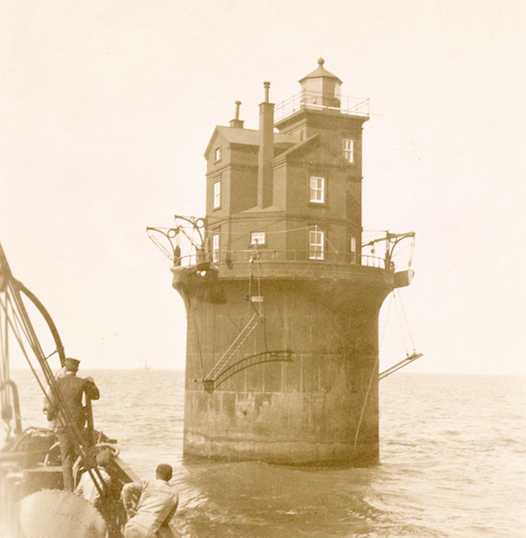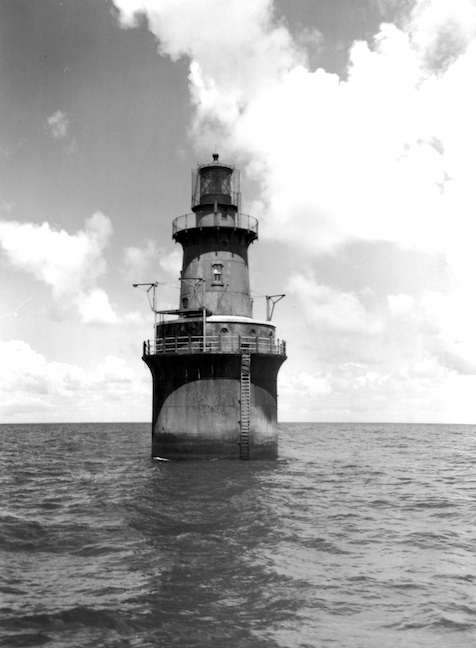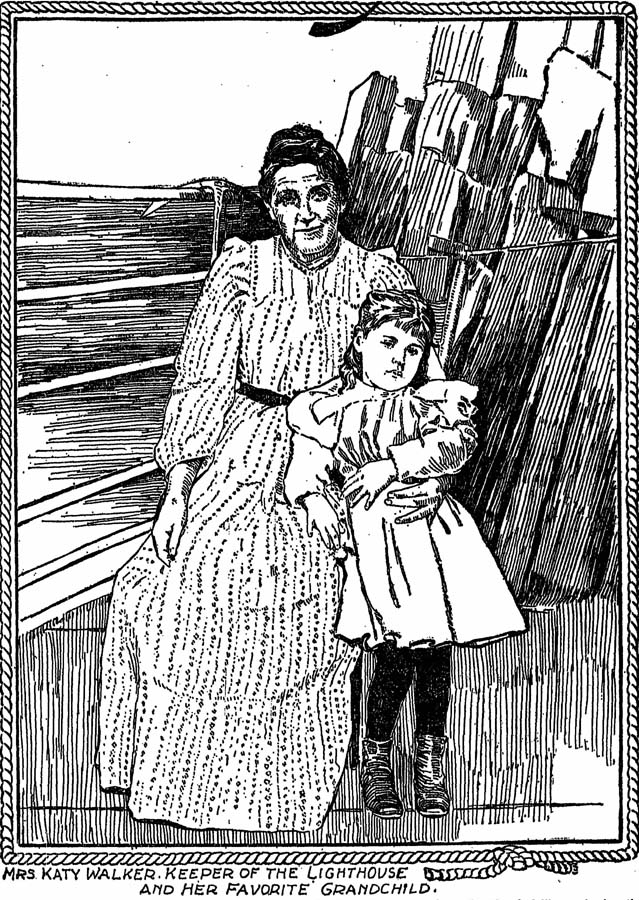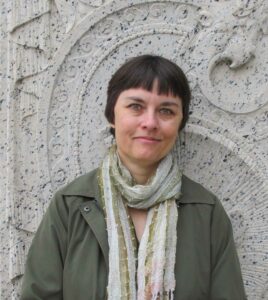Kate Walker here, keeping the light on Robbins Reef.
We talked earlier about lighthouses with caisson foundations. Let’s look at two caisson lights.

Fourteen Foot Bank Light Station stands in Delaware Bay near Bowers Beach. It was America’s first pneumatic caisson lighthouse structure, built in 1887. The U.S. Light-House Board (USLHB) Committee on Engineering reviewed and approved all lighthouse plans, sometimes recommending modifications or additions to the design. A letter from the Committee on Engineering to the Chairman, USLHB, on June 4, 1883, outlined their plan:
The Committee considers that . . . a cylinder 35 feet in diameter would present the most advantages. This cylinder should be sunk into the sand not to exceed 23 feet. The sand should not be excavated from the inside but remain at the same level as the sand outside. The rest of the cylinder should be filled with concrete, except the necessary space for cellar, fog signals, etc. To prevent scour, brush mattresses should be placed outside the cylinder, extending about 30 feet from the base, and then be loaded with a rip-rap of heavy stone for a distance of 6 to 8 feet above the bottom. The cylinder should extend 24 feet above high water mark. This will make the total length of the cylinder 73 feet.
On July 5, 1885, the wooden caisson, with three tiers of the iron cylinder built upon it, was towed to the site and sunk into position by letting water into it. The caisson was then filled with compressed air, and on July 23d had penetrated to a depth of 13 feet. On August 28 the required depth of 23 feet below the surface of the shoal was reached, and by the middle of September the contractors had finished the work of setting up the plates and filling into the cylinder 2,000 cubic yards of concrete.
Sabine Bank, Texas, was the only lighthouse along the Gulf Coast to be built with a caisson foundation. The caisson was towed to the site of the station, a distance of 16 miles, and was anchored to special clusters of mooring piles.

A working pier in the shape of a horseshoe, 90 feet by 60 feet in plan, was built at the site of the station, the caisson being located between the wings of this pier. On the pier were two stiff-leg derricks, boilers, engines, compressors, pumps, dynamo, cisterns, and quarters for the working party. About 300 tons of ballast rock was placed around the outside of the caisson to prevent scouring. The station was completed in March 1906.
On October 24, 1906, the District Engineer reported that a gale had pushed the sea so high “that it raised the roof of the gallery off of the gallery columns, and broke some of them . . ..”
In October 1915, “the sea washed the hatches off gallery floor, broke in the storm shutters on that floor, tore off the iron gallery roof and stanchions supporting it for three-quarters of the circumference of the tower, carrying away two boats in the davits.” The keepers were commended for staying on station until the need for fresh water compelled them to go ashore.
 Information is from National Archives Record Group 26 Entry 9; 1886 and 1904 Annual Report of the Light-House Board; and Lighthouse Service Bulletin No.46, pp. 181-182.
Information is from National Archives Record Group 26 Entry 9; 1886 and 1904 Annual Report of the Light-House Board; and Lighthouse Service Bulletin No.46, pp. 181-182.
Submitted April 10, 2018
* * * * *
U.S. Lighthouse Society News is produced by the U.S. Lighthouse Society to support lighthouse preservation, history, education and research. You can receive these posts via email if you click on the “SUBSCRIBE” button in the right-hand column. Please support this electronic newsletter by joining the U.S. Lighthouse Society if you are not already a member.
If you have items of interest to the lighthouse community and its supporters, please email them to candace@uslhs.org.

Candace was the US Lighthouse Society historian from 2016 until she passed away in August 2018. For 30 years, her work involved lighthouse history. She worked with the National Park Service and the Council of American Maritime Museums. She was a noted author and was considered the most knowledgable person on lighthouse information at the National Archives. Books by Candace Clifford include: Women who Kept the Lights: a History of Thirty-eight Female Lighthouse Keepers , Mind the Light Katie, and Maine Lighthouses, Documentation of their Past.

